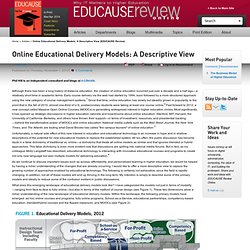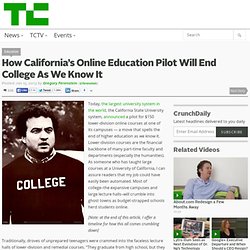

Conn... E-learning Samples. Online Adjunct Faculty - Ken Blanchard College ... MOOCs. Online Educational Delivery Models: A Descriptive View (EDUCAUSE Review. Phil Hill is an independent consultant and blogs at e-Literate.

Although there has been a long history of distance education, the creation of online education occurred just over a decade and a half ago—a relatively short time in academic terms. Early course delivery via the web had started by 1994, soon followed by a more structured approach using the new category of course management systems.1 Since that time, online education has slowly but steadily grown in popularity, to the point that in the fall of 2010, almost one-third of U.S. postsecondary students were taking at least one course online.2 Fast forward to 2012: a new concept called Massive Open Online Courses (MOOCs) is generating widespread interest in higher education circles. How California’s Online Education Pilot Will End College As We Know It. Today, the largest university system in the world, the California State University system, announced a pilot for $150 lower-division online courses at one of its campuses — a move that spells the end of higher education as we know it.

Lower-division courses are the financial backbone of many part-time faculty and departments (especially the humanities). As someone who has taught large courses at a University of California, I can assure readers that my job could have easily been automated. Most of college–the expansive campuses and large lecture halls–will crumble into ghost towns as budget-strapped schools herd students online. [Note: at the end of this article, I offer a timeline for how this all comes crumbling down] Instructional Design. A list of All The Best iPad Apps Teachers Need.
Coming to you from the Canadian Maritimes ( Halifax), Educational Technology and Mobile Learning is an educational blog dedicated to curating, reviewing and sharing EdTech tools and mobile apps.

The purpose is to help teachers and educators effectively integrate digital technologies into their day-to-day teaching, learning and professional development. For any questions regarding our website or the content we publish, please contact EdTech admin, editor and blog owner, Med Kharbach at: info@educatorstechnology.com. Principles of Instructional Technology. The History of Distance Learning - Infographic. In 1728, the first recorded instance of distance learning occurred in Boston, USA, when a "Caleb Phillips" advertises private correspondence courses in short hand in the Boston Gazette.

Would you be interested to know the rest of The History of Distance Learning? In 1840s, Sir Isaac Pitman runs correspondence courses teaching his revolutionary short hand system. Pitamn shorthand is still widely used today. In 1858, the University of London becomes the first university to offer distance learning degres. "Instructional Design" related terms, short phrases and links. CourseBuilderChecklist - course-builder - Checklist of all steps to create a course using Course Builder. - Course Builder.
Costs When you use Course Builder, you create your course as an App Engine application.

Currently, each App Engine application can consume a certain level of computing resources for free, controlled by a set of limits. If you need resources above these free limits, you can switch to a paid app to set a daily resource budget. For more information, see Develop with App Engine. Download and install All pathnames are relative to the directory containing Course Builder. Explore Explore Course Builder to get direct experience. Reigeluth, Charles - Educational Learning Theories. Charles Reigeluth, Ph.

D. Photo source: Charles Reigeluth is currently a professor at Indiana University. He earned his B.A. in Economics in 1969 from Harvard University and earned his Ph. D. in Instructional Psychology from Brigham Young University in 1977. Charles Reigeluth has founded the theory of and taught the principals of instructional design at Indiana University and at Syracuse University. What is Instructional Design? Instructional Design theory is a twin pronged instrument for facilitating learning and human development.
Reigeluth's (1999) model is illustrated. Social Media in the Classroom [INFOGRAPHIC] It shouldn’t come as a surprise that social media has changed more than just how we pass the time, it has now infused itself into formal learning channels.
![Social Media in the Classroom [INFOGRAPHIC]](http://cdn.pearltrees.com/s/pic/th/classroom-infographic-50863876)
Although adoption is slow (for instance, only 15% of teachers find value in Facebook, Wiki, and other social networks), time will only show that it will rise. Interestingly though, about one third of teachers surveyed for this infographic say they use social networking or social media for their instruction. Who am I? Conference on Higher Education Pedagogy (CHEP) Faculty are, on a daily basis and in very unassuming ways, demonstrating a renewed energy and focus toward the scholarship of teaching and learning.

This is further evidenced by our attention to academic assessment, the integration of technology and learning, and even in the change in our teaching lexicon as we incorporate active engagement and reflective practices into instruction to encourage authentic learning. Join us as we showcase and share our collective growth, innovation, and achievement in teaching and learning. Click to Play The fourth annual Conference on Higher Education Pedagogy is focused on Scholarly Teaching and showcases the best pedagogical research and practice in higher education today. APA Formatting and Style Guide. Summary: APA (American Psychological Association) style is most commonly used to cite sources within the social sciences. This resource, revised according to the 6th edition, second printing of the APA manual, offers examples for the general format of APA research papers, in-text citations, endnotes/footnotes, and the reference page. For more information, please consult the Publication Manual of the American Psychological Association, (6th ed., 2nd printing).
Contributors:Joshua M. OpenSSO (Login)